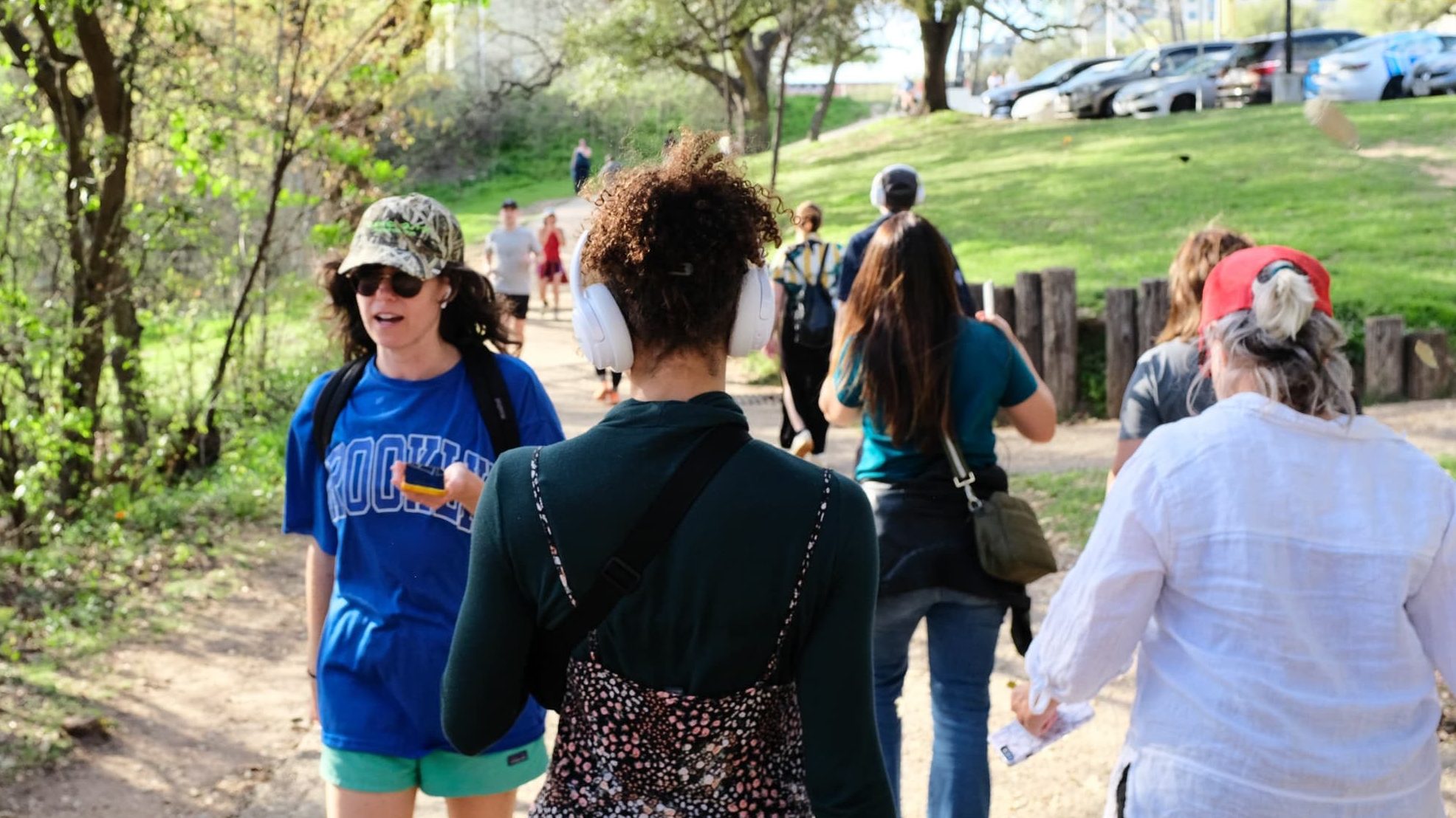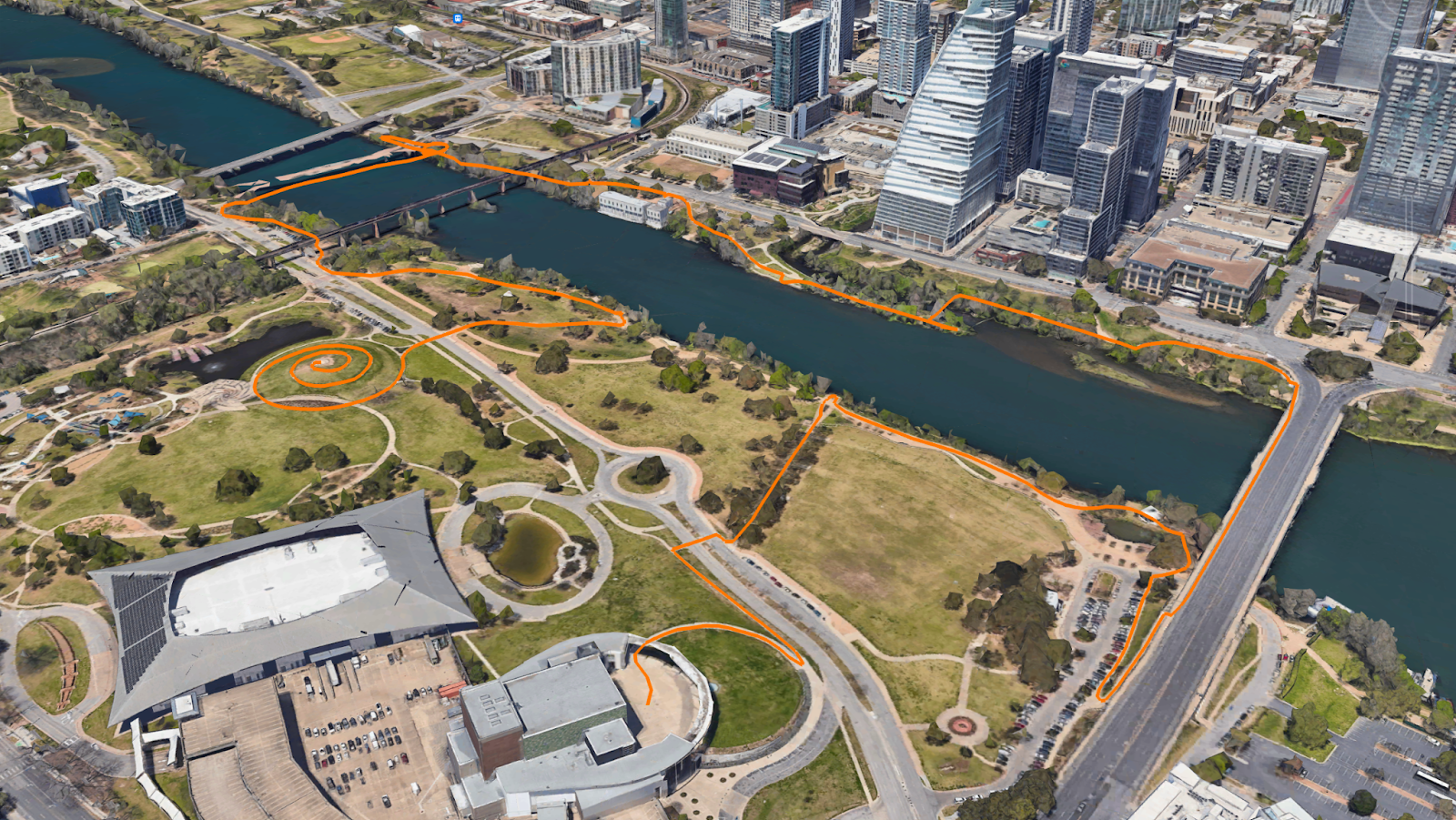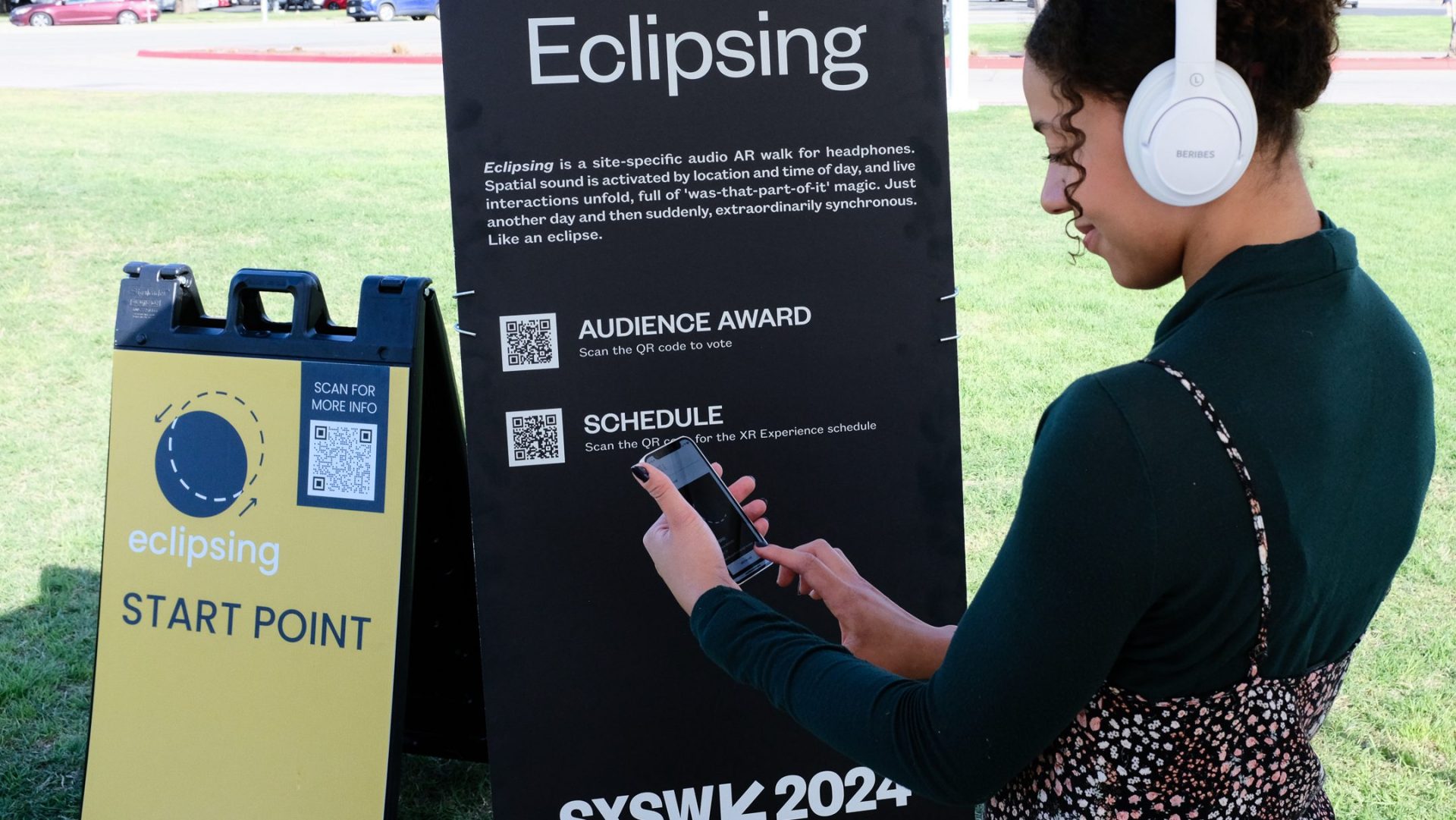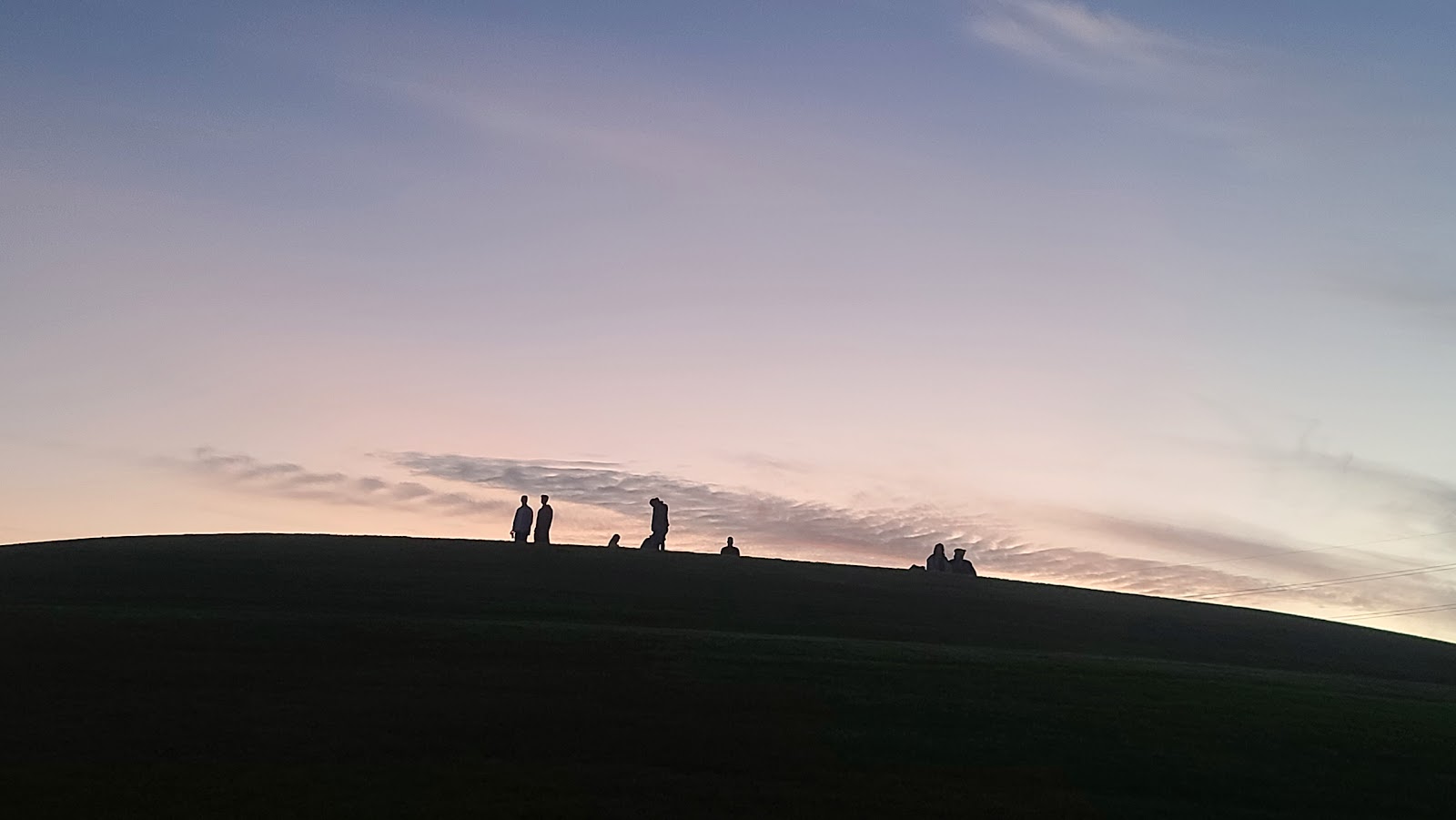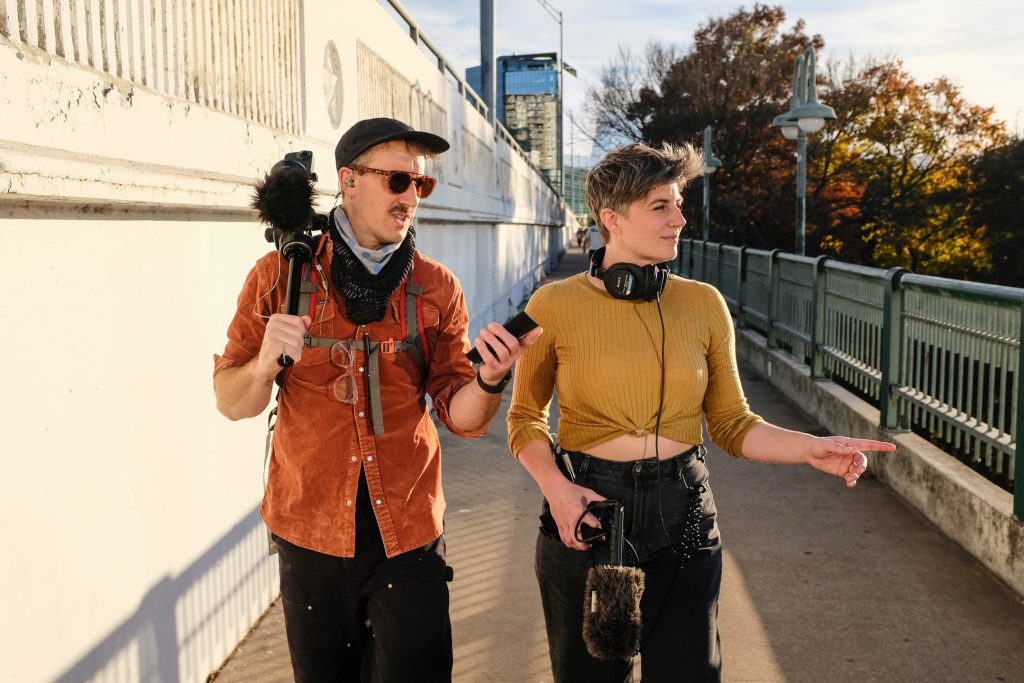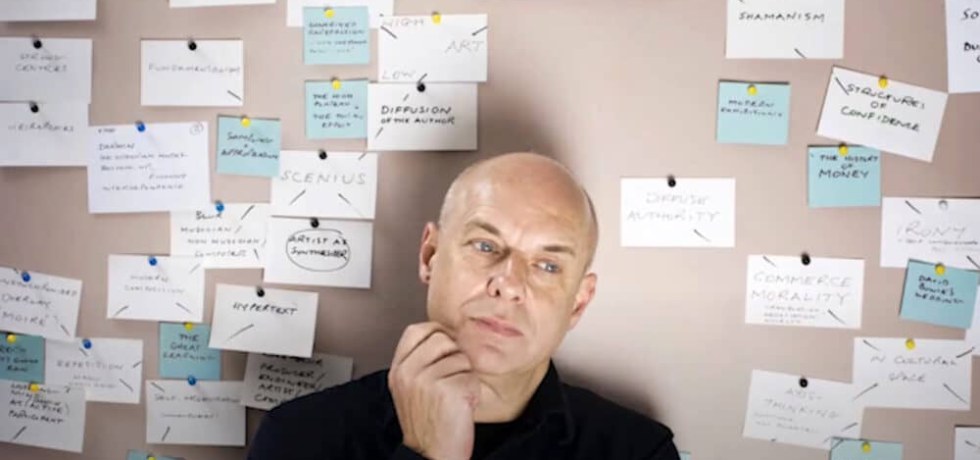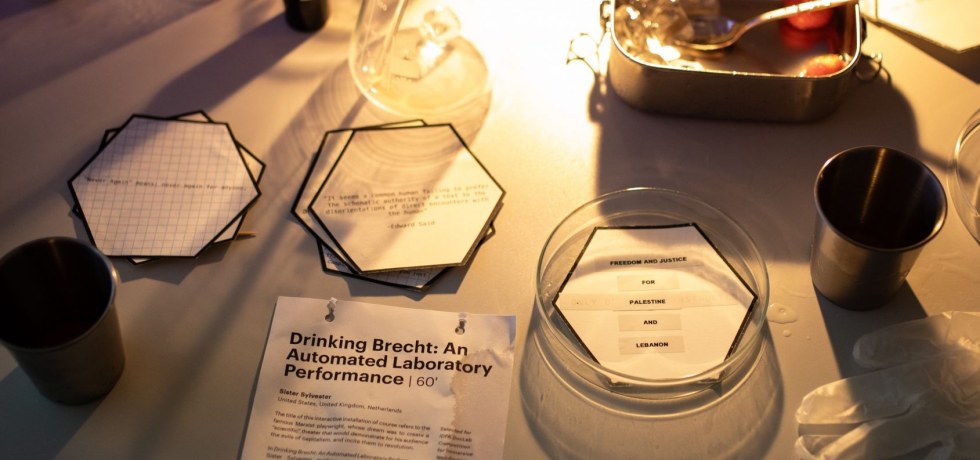Eclipsing
“A total eclipse is all about being in the right place at the right time. . . . Sometimes an entire city is in the right place at the right time. And sometimes just one person is.”
—Andrew Schneider
Eclipsing was a site-specific, two-mile-long soundwalk created for the 2024 total eclipse of the sun, which happened to coincide with the South by Southwest festival in Austin, Texas. Participants would download an app and listen to audio which led them on a walk through Austin’s Zilker Park while sharing information about the history of Austin, how eclipses work, and how science affects people’s daily lives. The walk was full of “was-that-part-of-it?” moments—sound activated by location and time of day, narration researched and recorded in Austin, and live interactions hidden in plain sight. Just another day, regular people doing regular things, and then suddenly, magically synchronous. Like an eclipse.
The work was created by Andrew Schneider and Annie Saunders, who collaborated with Carnegie Mellon University astrophysicist Katie Breivik to explore the concepts of the relativity of simultaneity, deep time, eclipse cycles, and star formation. It was developed with input from the local community and in partnership with the Long Center for the Performing Arts in downtown Austin. The project was made possible by the Simons Foundation, established by the late hedge fund manager Jim Simons and his wife Marilyn Simons to support research in mathematics and basic science, as part of the foundation’s 2024 “In the Path of Totality” initiative.
Point A is a collaboration between interdisciplinary artists Andrew Schneider and Annie Saunders. They create site-responsive artworks that combine performance, installation, interactivity, sound art and new technologies and take place in public spaces.
Schneider is an OBIE award-winning performer, writer and artist who has created original works for theater, dance, sound, video, and installation since 2003. A member of the New York arts incubator Onassis ONX, he has conducted master classes on technology and performance at Bowdoin, Carleton and Connecticut College and teaches a recurring class on original-flavor reality at New York University’s Interactive Telecommunications Program. He holds a BFA in Theater Arts from Illinois Wesleyan University and a masters degree in interactive telecommunications from NYU.
Saunders is a multidisciplinary creator and director of site-specific experiences. She has created award-winning multi-platform projects for major arts institutions, including the Public Theater in New York and the Los Angeles Philharmonic, as well as site-specific projects in disused spaces set for demolition and experiential campaigns for such multinational brands as HP, MasterCard, Dos Equis, Bulleit and ASICS Worldwide.
Working together as Point A, Schneider and Saunders had created two earlier location-and-time-based soundwalks. Current, a lower Manhattan soundwalk commissioned by the arts development arm of Brookfield Properties, won the Tribeca Festival’s 2021 Immersive Award for Creative Nonfiction. The New York Times described it as “casual, edifying and candid, asking us to consider the overlapping landscapes of the cemented-over wetlands, the skyscraper canyons, the storm surges — linking the city’s beating heart with the organs of our own bodies and questioning how, after so much distress, we might rebuild.” Kormós, a series of walks in Athens, was created for the Onassis Foundation’s 2022 exhibition Plásmata: Bodies, Dreams, and Data in Pedion tou Areos, the city’s largest public park. Prodromos Tsiavos, Head of Digital & Innovation at the foundation’s Onassis Stegi cultural center, called it “a narrative that triggered emotions, challenged preconceptions, and revealed hidden stories.”
Katelyn Breivik, who collaborated with Saunders and Schneider on Eclipsing, is an assistant professor of astrophysics and cosmology at Carnegie Mellon University and its McWilliams Center for Cosmology and Astrophysics, set up to establish CMU as a leading center for research at the crossroads of astrophysics, data science and artificial intelligence/machine learning, with a mission to understand the origins of the universe and the fundamental principles that govern it. She joined CMU after earning her M.S. and Ph.D. in physics and astronomy at Northwestern University and serving as a research fellow at the Flatiron Institute’s Center for Computational Astrophysics in New York. Her involvement in Eclipsing came through the Simons Foundation’s Triangle Program, which seeks to bring art and science together.
Lance Weiler: I’m excited to talk with you about your project, Eclipsing. Let’s dive right in. When you’re working with something as vast and ephemeral as an eclipse—or other large-scale, data-driven phenomena in public spaces—how do you even begin? What’s the first step in designing an experience like Eclipsing?
Annie Saunders: That’s such a thoughtful question, and I appreciate the angle. So often, questions lean toward the logistical or production-focused side, which I can absolutely speak to, but I love the research phase—the interviews, the large aperture of material intake before we decide what the audience is actually going to hear.
With Eclipsing, the project was initiated by the Simons Foundation, which focuses on making science more accessible in the public sphere. They commissioned seven public artworks in cities along the path of the eclipse across North America. It was called the Triangle Grant—the triangle being made up of the artist, a scientist, and a venue or producer in a location experiencing totality. In our case, that was myself and Andrew as the artists, Katie Breivik, a computational astrophysicist from Carnegie Mellon, and the Long Center in Austin. So this wasn’t a case of us saying, “Let’s make something about an eclipse.” It started with a prompt: create public art that inspires conversation and wonder around the eclipse.
Artistically, my first step is always a site visit. A huge amount of the work is generated by the location. Sometimes there’s a theme attached—sometimes not. Regardless, a deep exploration of the site is always the beginning.
Andrew and I went to Austin about a month after we got the funding. We walked the site, made long recordings, and captured ambient sounds. One of the primary goals of that visit was to determine the walk’s route—or at least a rough idea of it. It’s all about deep listening and observation, looking for things you wouldn’t find on an historical tour. Details that aren’t signposted to be noticed.
Our wayfinding often includes mundane but distinct things: a broken lamppost, a mosaic tucked away on a wall—things that ground the audience in the real world. And I talk to everyone I can: locals, experts, artists—anyone connected to the themes we’re exploring.
For Eclipsing, we were drawn to ideas of alignment, synchronicity, coincidence, being in the right place at the right time. Those everyday moments that feel magical. We gathered all of that into giant thematic buckets—coincidence, alignment, the science of eclipses—paired with interviews, especially with Katie. From there, it became about finding poetic metaphors within those themes.
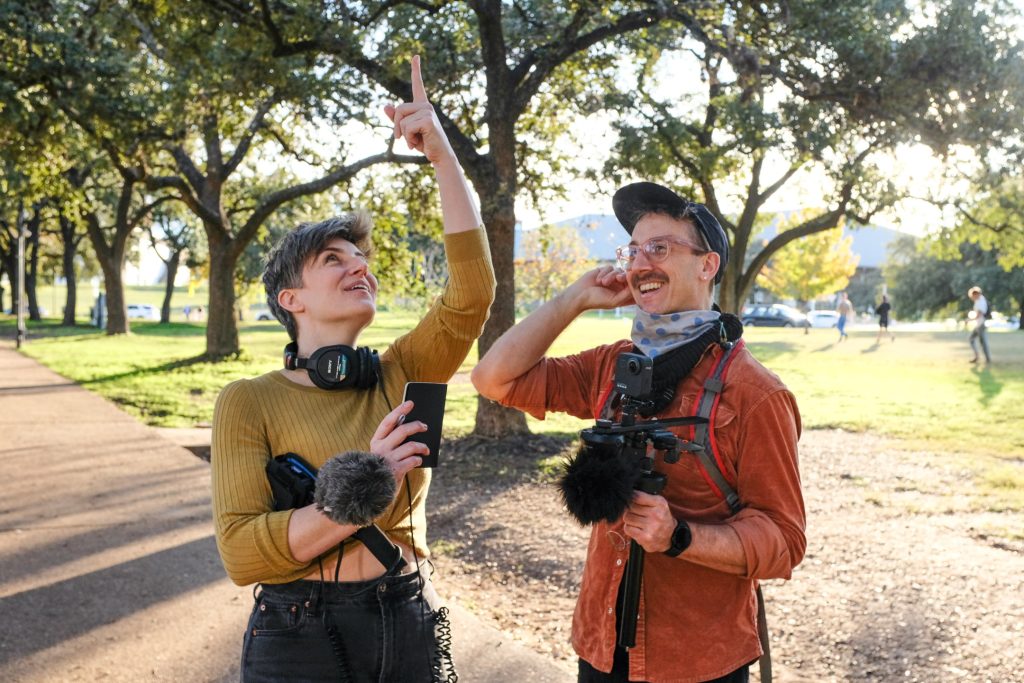
Lance: I love that level of detail. Let’s keep going—how do you shape a narrative that unfolds across physical space, rather than on a screen or page? How do you think about space as a storytelling medium?
Annie: There’s an anecdote that really illustrates this. One of the most important things to me in performance-making, whether it’s indoors or outside, is the control of space and time. That’s the definition of theatricality—controlling both space and time for the audience. In these sound walks, we have very limited control over the physical environment, so we focus intensely on what we can control: the timing and the auditory complexity.
At one point, Eclipsing just wasn’t working. We had too much going on in the audio: history, science, personal stories, layered performance. It became overwhelming. We’d listen and check out after 15 minutes. We realized we had front-loaded way too much. We learned that the beginning needed space—literal silence. People are just starting to understand what the experience is. So we started stripping back: “Here’s a sidewalk. We’re going to walk. Here’s one thematic idea.”
One breakthrough came from noticing electrical interference in the microphones. That became a metaphorical and sonic doorway into the science of eclipses. Another key lesson: always create the piece for the walking experience. If it doesn’t work while walking, it doesn’t work, no matter how poetic it sounds on paper, or even through headphones at a desk. It must work in motion.
We also structure the walks like a piece of music. The route is the foundation. The directions are the drum track. They get tested on their own—just ambient sound and navigation. Once they’re locked in, they’re fixed. You have exactly 18 seconds to say something about a tree or it’s not in the show. That structure is how we honor the physical experience of the audience. It’s not a lecture—it’s a walk.
Lance: That’s such a beautiful, layered approach. I’m curious—how do you prototype something so complex and site-specific? What tools do you use to test these spatial experiences?
Annie: Internally, once we’ve determined the route, we record spatial audio and capture 360-degree video. That way, we have a reference for timing and environmental sound without having to visit every day.
Then it becomes about finding the poetry of the route. In Austin, the walk is a loop—but not quite. You see where you just were multiple times. That physical reality echoed the eclipse’s themes of cycles and alignment. So we pulled that resonance through into the narrative.
Another critical piece is footstep cadence. There’s a consistent walking rhythm embedded in the audio—another track in the mix that doesn’t change. We determine places for people to stop—not just to rest but to digest the audio. Those become checkpoints that reset the group’s timing.
For Eclipsing, we had an app for the performers, with their own track. It let them receive cues and directions separate from the audience’s narrative, so their presence aligned perfectly without giving away the trick.
We test on different phones, headphones, and environments. And we’re obsessive about media management—file naming, labeling, indexing, transcribing. Our recordings span months, and it sounds like it was all done in one take. But it’s tiny slices, carefully curated.
And finally—spiritual tools. Patience. Working in public means weed whackers, volleyball games, surprise construction. Adaptation and acceptance are part of the craft.
Lance: I love how your process embraces emergence, the unknown, and adaptation. What were some of the biggest challenges you faced with Eclipsing? And were there any surprises that shifted the project?
Annie: The unpredictability of public space was a big challenge. You plan a recording day, and there’s weed whacking or construction. Another big one: about a month before launch, we had to move our start point. We’d spent months recording at the original location. But due to internal scheduling at the Long Center, another production booked the same space. Suddenly, we had to find a new beginning, rewrite, and re-record—on the fly. Ultimately, though, I liked the new starting point better. It mirrored the ending and was easier to find. A classic example of a creative constraint turning into an opportunity.
One ongoing challenge with this kind of work is communicating its intensity to institutional partners. People hear “sound walk” and think it’s low-impact. But we approach it like building a sculpture in public space—only it’s invisible. That means wayfinding, signage, and discovery are even more critical. The work doesn’t announce itself. You have to find it.
Lance: What about surprises? Anything that really caught you off guard in a good way?
Annie: Almost the entire process is built around being surprised. That’s what the scriptwriting is—go for a walk and see what surprises you. But every time, what surprises me most is how the piece eventually reveals itself. You keep gathering pieces, unsure how they’ll fit, and then suddenly the thing forms. It knows what stays, what goes, and it tells you when it’s ready.
And then there’s synchronicity. We’d mention a guy jogging in a weighted vest, and then audiences would see him. Repeatedly. Or a detail like an overflowing trash can becomes the most memorable part for someone. You spend months refining eclipse science, and the moment that lands is a trash can. That kind of magic never gets old.
And in Eclipsing, the performers at the end often made people cry. Seeing someone again and again, realizing they were part of the piece—it was powerful. That idea of serendipitous presence is really what I chase artistically. The feeling that something simple and human—like seeing someone again—can be profoundly moving.
Lance: That’s beautifully said. Final question—what advice would you offer to other makers, especially those exploring immersive or site-based work?
Annie: Lean into the low-tech version. We tested expensive recording equipment, but the cheaper, lower-profile stuff gave us better results. It picked up more authentic ambient sound and didn’t draw attention. When I taught a class at UC Davis, students recorded on their phones and made amazing work. You don’t need fancy gear to create something magical. Just make the low-tech version.
Also, test in the actual location. So much outdoor audio work is clearly recorded in a studio—it breaks the immersion. Be where you are.
And always make the work from the audience’s perspective. Not to pander, but to embody them. When I create, I imagine myself as the audience. What would I want to experience? That becomes the foundation.
Finally, consider the emotional tone before anything else. What do you want to have happen to you? When we made Current during the pandemic, I asked myself, “What do I want right now?” The answer: I want someone to meet me and take me by the hand for a walk. So we built the experience to feel exactly like that.
Lance: That’s a perfect place to close. Thank you, Annie, for sharing your practice and process with such generosity. Your work is a powerful reminder of the magic that can emerge from presence, patience, and place.
Annie: Thank you, Lance. This was such a meaningful conversation.
